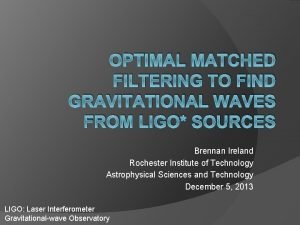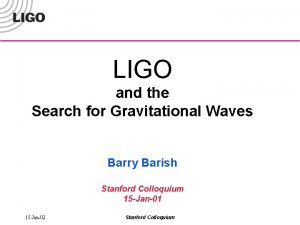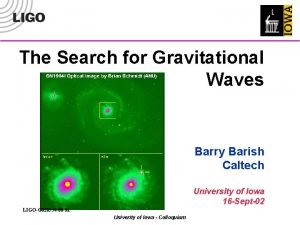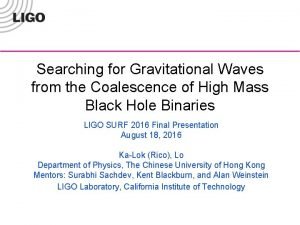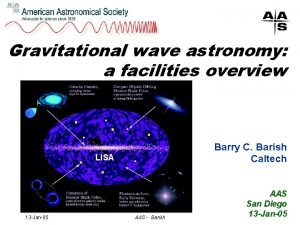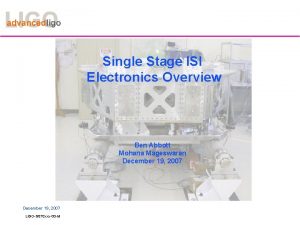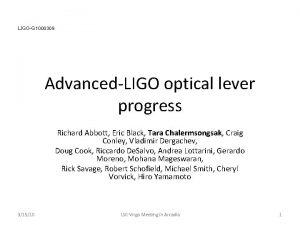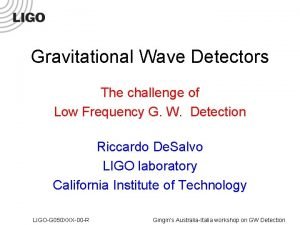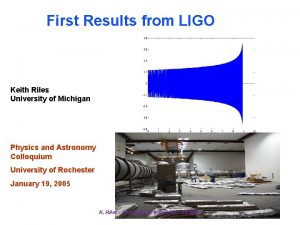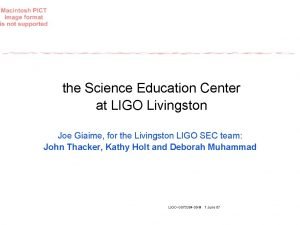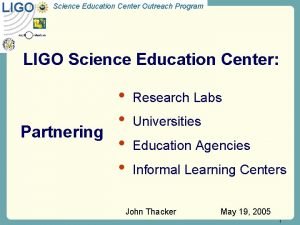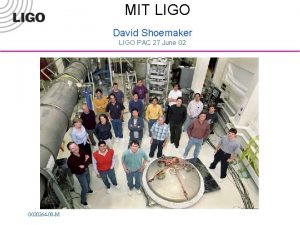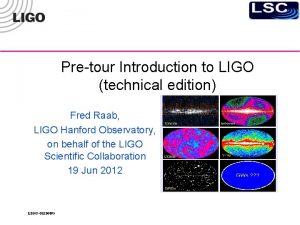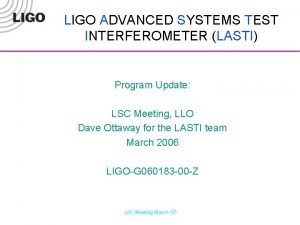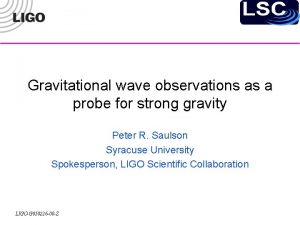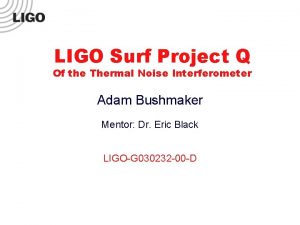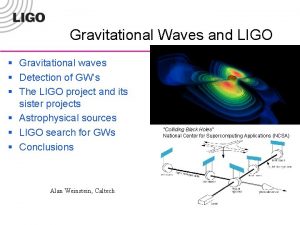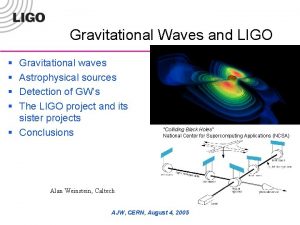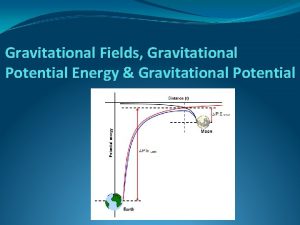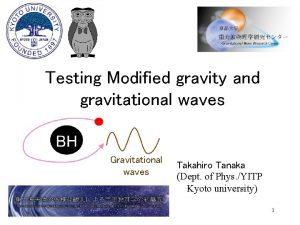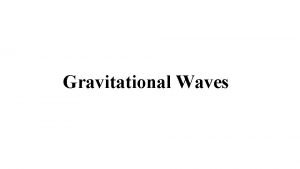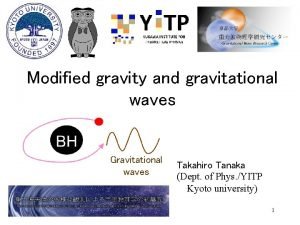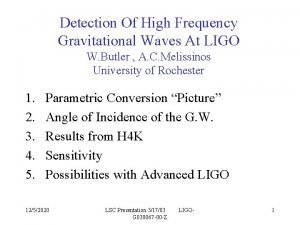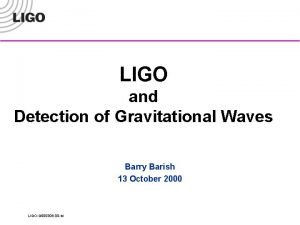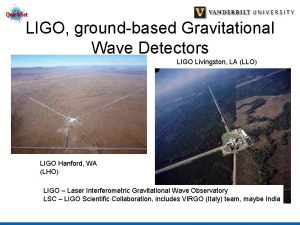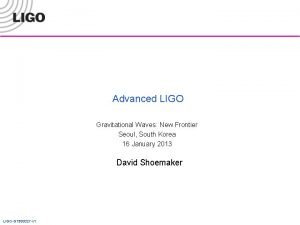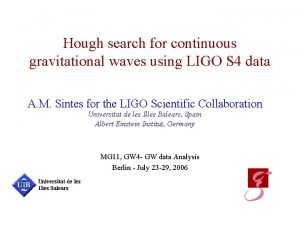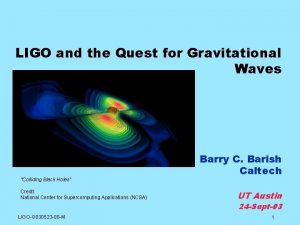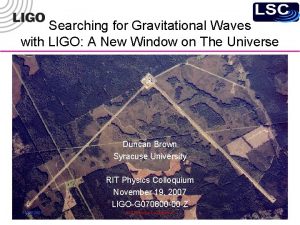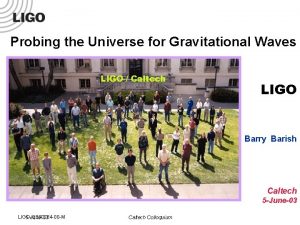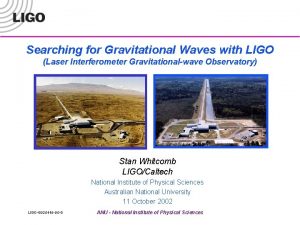The first detection of gravitational waves with LIGO































- Slides: 31

The first detection of gravitational waves with LIGO Philip Charlton School of Computing and Mathematics Charles Sturt University LIGO-G 1601091

GW 150914 On September 14, 2015 at 5: 50 am ET (7: 50 am AEST) the Laser Interferometric Gravitational-wave Observatory (LIGO) detected the inspiral and merger of a pair of black holes, dubbed GW 150914. This event is the first direct detection of gravitational waves.

http: //journals. aps. org/prl/abstract/10. 1103/Phys. Rev. Lett. 116. 061102

http: //www. aciga. org. au

Newton’s gravity m r M

Einstein’s gravity Sources of the gravitational field are matter and energy Speed of light c = 3× 108 m/s is constant and nothing can exceed it Instead of space we have space-time with coordinates (ct, x, y, z) The gravitational field gab is a tensor instead of a vector. Think of it as a 4× 4 array of numbers

Examples If there were no matter in the Universe at all, we would be living in Minkowski space. This is the ‘flat’ space of special relativity.

Examples In the exterior region of a star or a black hole we have Schwarzschild space.

Einstein’s equations

Einstein’s equations Matter and energy causes space to curve Sources are matter and energy Field tells matter how to move

Experimental confirmation 1916 Precession of the perihelion of Mercury 1919 Deflection of light by the sun confirmed by Eddington and collaborators 1959 Gravitational redshift confirmed by Pound and Rebka 1974 Orbital decay in a binary pulsar system observed by Hulse and Taylor 1979 Gravitational lensing exhibited by the Twin Quasar 2011 Frame dragging confirmed by Gravity Probe B

Solving Einstein’s equations are a set of ten coupled differential equations for gab They are non-linear Difficult to solve, even by computer To find exact solutions, we need to make simplifying assumptions

Solving Einstein’s equations Assume: Space-time is ‘flat’ Minkowski space plus a small perturbation: No matter nearby: Gives us linearised Einstein’s equations in vacuum

Gravitational wave solution The linearised equations can be solved to give a wavelike perturbation propagating at the speed of light— a gravitational wave!

European Space Agency http: //www. esa. int

Sources of gravitational waves Spinning neutron stars Supernovae The Big Bang Inspiral and merger of a pair of black holes or neutron stars

Evidence for gravitational waves In 1974, MIT astronomers Hulse and Taylor discovered a binary pulsar system. This plot shows that the observed periastron shift is in excellent agreement with that predicted due to the emission of gravitational waves. For this discovery, Hulse and Taylor were awarded the 1993 Nobel prize in Physics. ASP Conf. Ser. 328 (2005) 25

Observing gravitational waves A passing gravitational wave causes tiny changes in length, of the order of 1 part in 1021. This is the equivalent of a change in the distance between here and the nearest star by the width of a human hair.

Laser interforemetry A laser interferometer is ideal for measuring small changes in length. A passing gravitational wave causes one arm to shrink and one to expand, resulting in a tiny change in the arm length ΔL. The strain h is the fractional change in the arm length.

Interferometer animation https: //www. ligo. caltech. edu

LIGO Begins 1984 LIGO steering committee is formed Rai Weiss Ron Drever Kip Thorne

Timeline 1994 With Professor Barry Barish as director, NSF funds LIGO for $US 395 million. Construction begins at Hanford, WA and Livingston, LA 1999 LIGO inauguration 2006 First gravitational wave searches at design sensitivity 2010 Advanced LIGO installation begins 2014 Advanced LIGO complete 2015 Sensitivity 3× initial LIGO is achieved

Observatories LIGO Hanford, Washington 4 km 3000 km LIGO Livingston, Louisiana https: //www. ligo. caltech. edu

September 14, 2015: 5: 54 am ET l Coherent Wave. Burst (CWB) reports the event via automatic e-mail l Coherent Wave. Burst crew is on guard. l This is high mass binary inspiral! l Looks real! Lets start detection check-list procedure. Super Mario Galaxy Klimenko, October 7, BNL colloquium, Long Island, NY LIGO-G 1300099 24

The event Phys. Rev. Lett. 116, 061102 (2016)

Sound https: //www. ligo. caltech. edu

Strong evidence of a GW Coincident in both detectors, arriving within the light travel time of 10 milliseconds Consistent with the waveform predicted by general relativity for the inspiral and merger of a pair of black holes No test signals had been inserted at this time False alarm rate for a signal this ‘loud’ is less than 1 every 200 000 years

What the waveform tells us Inspiral of a pair of black holes, 36 and 29 solar masses, about 1. 3 billion years ago Merges into a single 62 solar mass black hole Energy of 3 solar masses radiated as gravitational waves Phys. Rev. Lett. 116, 061102 (2016)

Informa https: //www. ligo. caltech. edu

Merger animation https: //www. ligo. caltech. edu

What comes next LIGO has made the first observations allowing us to test Einstein’s theory under dynamical, extremegravity conditions. Just as the invention of the radio telescope opened up a new part of the spectrum for astronomers, LIGO has opened up a new window on the Universe which will lead to new and unexpected discoveries – the beginning of gravitational wave astronomy.
 Matched filtering gravitational waves
Matched filtering gravitational waves Gravitational waves
Gravitational waves Gravitational waves
Gravitational waves Gravitational waves
Gravitational waves Gravitational waves
Gravitational waves Differences between mechanical and electromagnetic waves
Differences between mechanical and electromagnetic waves Sound is a transverse wave true or false
Sound is a transverse wave true or false Mechanical waves and electromagnetic waves similarities
Mechanical waves and electromagnetic waves similarities Differences between mechanical and electromagnetic waves
Differences between mechanical and electromagnetic waves What type of waves are sound waves? *
What type of waves are sound waves? * Is echolocation transverse or longitudinal
Is echolocation transverse or longitudinal Short wave vs long wave radiation
Short wave vs long wave radiation Mechanical waves and electromagnetic waves similarities
Mechanical waves and electromagnetic waves similarities Mechanical vs electromagnetic waves
Mechanical vs electromagnetic waves Mechanical and electromagnetic waves similarities
Mechanical and electromagnetic waves similarities Surface waves and body waves
Surface waves and body waves Is a seismic wave mechanical or electromagnetic
Is a seismic wave mechanical or electromagnetic Compare and contrast p waves and s waves using venn diagram
Compare and contrast p waves and s waves using venn diagram Venn diagram of mechanical and electromagnetic waves
Venn diagram of mechanical and electromagnetic waves Difference between constructive and destructive waves
Difference between constructive and destructive waves Mohanna muffak
Mohanna muffak Ligog
Ligog Ligo challenge xxx
Ligo challenge xxx Hanford
Hanford Ligo science education center
Ligo science education center Ligo science education center
Ligo science education center David shoemaker ligo
David shoemaker ligo Ligo
Ligo Ligo
Ligo Ligo
Ligo My project q
My project q Ligo
Ligo
